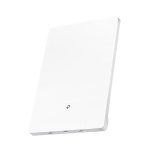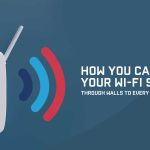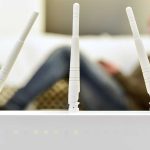To get the strongest Wi-Fi signal, place your router in a central, elevated spot away from obstructions and interference. Avoid hiding it behind furniture or near electronic devices that can disrupt the signal. Using these simple tips will significantly boost your internet speed throughout your home.
For the best Wi-Fi performance, position your router in a central, high location, free from thick walls and electronic interference. Keep it away from metal objects and large appliances, ensure it’s elevated off the ground, and avoid placing it near mirrors or large metal surfaces. These strategic adjustments help improve signal coverage and speed for all your devices.
Getting your Wi-Fi router right can be a game-changer for your home internet experience. Often, people experience slow connections or dead zones simply because the router isn’t ideally placed. Positioning your router correctly is easier than you think — just choose a central spot, elevate it, and keep it clear of obstructions. This simple step can deliver faster, more reliable internet across your entire household, making streaming, gaming, and working from home smoother and more enjoyable.
How to Position WiFi Router for Best Signal
Understanding WiFi Signal Basics
WiFi signals spread out in all directions from your router. The strength of the signal depends on where the router is placed and what objects are around it. Knowing how WiFi works helps you find the best spot for your device.
Choose the Right Location for Your Router
Placing your router in the right spot is key to getting good WiFi coverage. Keep it in a central location in your home so the signal reaches all rooms evenly. Avoid placing it near walls, metal objects, or appliances that can block signals.
Keep It Elevated
Position your router on a high shelf or mount it on a wall if possible. Elevation helps the signal travel downward and outward more effectively. Avoid placing it on the floor where signals can get trapped or weakened.
Place Away from Obstructions
Furniture, mirrors, and large appliances can block WiFi signals. Keep your router away from these objects to prevent weakening the signal. Also, avoid placing it behind thick walls or inside cabinets.
Maintain Optimal Distance from Interference Sources
Other electronics can interfere with WiFi signals. Keep your router away from devices such as cordless phones, microwave ovens, and baby monitors. This reduces signal interference and improves your connection quality.
Identify and Minimize Source of Interference
Use your router away from Bluetooth devices, wireless speakers, and baby monitors that operate on similar frequencies. This prevents signal disruption for a smoother internet experience.
Adjust the Router’s Antennas for Better Coverage
If your router has adjustable antennas, position them for maximum coverage. Generally, pointing one antenna vertically and another horizontally helps spread signals in multiple directions.
Experiment with Antenna Angles
Try different angles to see which provides the best coverage in your space. Sometimes slight tilts or rotations improve signal strength in specific areas of your home.
Use External Antennas if Available
Some routers allow for attaching external antennas. High-gain antennas can focus WiFi signals toward specific parts of your home, boosting overall performance.
Optimize Router Placement for Different Types of Homes
Your home’s layout influences the best placement for your WiFi router. Consider the size, shape, and construction materials of your house.
For Large Homes
Place your router in a central location, ideally on the main floor with open access to all areas. Use WiFi extenders or mesh networks to cover distant rooms.
For Apartments or Small Houses
Position your router in a common area like the living room or near the center of your space. Keep it away from walls and metal objects to improve signal reach.
Utilize WiFi Range Extenders and Mesh Networks
If your home has WiFi dead zones, boosting the signal with extenders or mesh systems is effective. These devices can help blanket your entire home with strong WiFi coverage.
WiFi Range Extenders
Place extenders halfway between your router and the area where the signal weakens. They rebroadcast the WiFi signal further into difficult spots.
Mesh WiFi Systems
These systems use multiple nodes to create a unified network across your entire home. Proper placement of nodes ensures consistent WiFi strength throughout the space.
Test and Adjust Your WiFi Signal
After positioning your router, test the WiFi signal in different rooms. Use apps or tools designed to measure WiFi strength to identify weak spots.
Use WiFi Analyzing Tools
Download free apps that can show signal strength and network speed in real-time. This helps you find areas with poor coverage and adjust your router’s placement accordingly.
Make Small Changes and Re-test
Shift the router slightly, then re-measure the signal strength. Small adjustments often make a significant difference in WiFi quality.
Additional Tips for Better WiFi Performance
Besides positioning, other simple actions can improve your WiFi experience.
- Update Your Router Firmware: Keep your router’s firmware current for optimal performance and security.
- Secure Your Network: Use strong passwords to prevent unauthorized users from slowing down your WiFi.
- Limit Connected Devices: Too many devices can strain your network. Disconnect devices not in use.
- Change WiFi Channels: Switch to less crowded channels to reduce interference from neighboring networks.
Summing Up the Best Practices for WiFi Router Placement
Position your router centrally in your home, elevated on a shelf or wall, and away from interference sources. Adjust antennas for maximum coverage, and consider extenders or mesh systems for larger spaces. Regular testing and small tweaks ensure you consistently enjoy strong, reliable WiFi.
By following these steps, you can significantly improve your WiFi signal, making internet browsing, streaming, and gaming smoother across your entire home. Proper placement combined with other optimization tips creates a powerful and dependable wireless connection.
Fix Your Wi-Fi Signal Instantly – Router Placement Tips!
Frequently Asked Questions
Where should I place my Wi-Fi router to ensure the best coverage?
Position your Wi-Fi router in a central location within your home, ideally on a higher shelf or mounted on a wall. Avoid placing it near thick walls, metal objects, or large appliances, which can interfere with the signal. Keeping it away from corners and other electronic devices helps maintain a strong, even signal throughout your space.
How can I prevent interference from other electronic devices affecting my Wi-Fi signal?
Locate your router away from other electronic gadgets such as cordless phones, microwave ovens, and Bluetooth devices. These can operate on similar frequencies and cause interference. Using a different Wi-Fi channel or switching to less congested frequencies (like 5 GHz) can help minimize disruptions and improve connection quality.
What role does antenna placement play in optimizing Wi-Fi signal strength?
Adjust your router’s antennas to point vertically if you want to extend coverage across multiple floors, and angle them for better horizontal spread. Some routers have adjustable antennas, so experiment with their positions to find the optimal setup that delivers a stronger signal to your most-used areas.
Should I keep my Wi-Fi router away from large furniture or metallic objects?
Yes, place your router away from large pieces of furniture and metallic objects, as these can block or reflect Wi-Fi signals. An open space without obstructions helps ensure that the wireless signal reaches all corners of your home without significant degradation.
Final Thoughts
Positioning your wifi router correctly enhances signal strength and coverage. Place the router in a central, open location away from walls and obstructions to maximize its reach. Keep it off the floor and away from electronic devices that may cause interference.
Ensuring the router is positioned at an elevated height can also help improve signal distribution. Avoid placing it near metal objects or thick walls that block the signal.
In conclusion, how to position wifi router for best signal involves choosing a central, elevated spot free from obstructions. Proper placement ensures a stronger, more reliable connection across your space.




